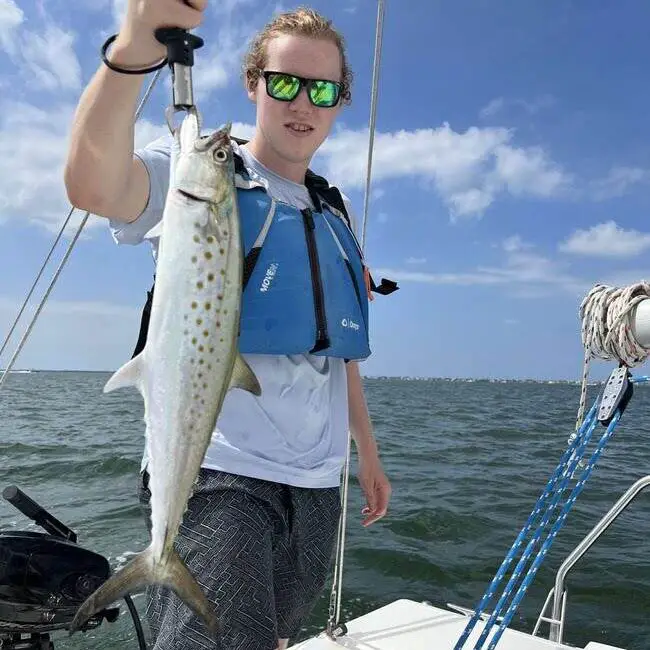Spanish Mackerel are fast and voracious predators that can be difficult to land due to their forceful attitudes and sharp teeth.
These 3 Spanish Mackerel rigs will help keep them biting and staying on the hook!
This post may contain affiliate links. As an Amazon Associate, I earn from qualifying purchases
Table of Contents
Mackerel Tree
A mackerel tree is another multi-hooked rig that is aimed at maximizing presentation and hookup ratio.
A mackerel tree most commonly consists of 3-6 J hooks that are tipped with surgical tubing suspended above a spoon or jig.
The spoon or jig at the bottom provides the weight to cast the rig and doubles as an extra lure, while the hooks with tubing bounce around and entice the fish to bite.

The advantages of a mackerel tree are that you have multiple lures, increasing your chances of a bite, you have multiple types of presentation on one rig, helping cover more possibilities, and you have the chance to get multiple fish at once.
You may also like: When Do Spanish Mackerel Run? State By State Patterns
How to Fish a Mackerel Tree
Mackerel trees can be fished in many ways and all are very effective.
You can vertically jig it from a pier, cast and straight retrieve, cast and jig, or a troll behind a boat. This is one of those rigs that slays with pretty much any retrieval style.
How to Tie a Mackerel Tree
First tie on your bottom lure to a few feet of 30-60 lb leader.
I would recommend a casting spoon or diamond jig that is at least 1 ounce. Next, move up the line 8-12 inches and tie a dropper loop. Put this loop through the eye and around the shank of your J hook to attach it.
To make the tube section, cut 2-3 inches of surgical tubing at a diagonal angle to taper it.
Now thread the hook through the tubing and out the tapered end. You can secure this with glue if you want but it isn’t necessary. Repeat this as many times as you want.
After you have tied all of your tube hooks on, just tie a swivel at the top and you’re all set!

Bubble Rig
The bubble rig is an extremely versatile type of float rig for any type of surface fishing you want to do.
The bubble rig consists of a special kind of bubble float tied above a bead and a swivel, which is then connected to your leader and bait.
The “bubble” in a bubble rig is a plastic sliding float that is rigged similarly to a popping cork.
This float, however, is made of hollow, transparent plastic. The clearness of the float makes it less detectable to keen fish like Spanish Mackerel.
You can also fill these floats partially with water. This gives them more weight to cast while remaining transparent.

Bubble rigs can be used to fish many different types of bait and lures. You can suspend live bait such as greenbacks or shrimp underneath the bubble or use lures such as spoons, flies, and soft plastics.
Some people even use plastic straws or tubing as a lure to great effect.
The bubble rig allows you to draw more attention to your bait without spooking fish, you can cast out lighter lures such as small spoons and flies, and you can keep your bait suspended with better results in clear water.
How to Fish the Bubble Rig
A bubble rig should be primarily fished like a popping cork. Jerk your rod to bring the bubble towards you, reel in the slack, then wait 2-5 seconds and repeat.
Jerking the bubble creates commotion on the surface that attracts fish.
This will bring your bait or lure closer to the surface and allow it to sink back down, giving it a lively up-and-down action.
How to Tie the Bubble Rig
First, thread your main line through the bubble. Next, put your main line through a bead and tie it to a barrel swivel.
The bead will help protect your knot from being worn by the float. Then tie on 1-2 feet of 30-60 pound test monofilament or fluorocarbon leader line. Now tie on your desired hook or lure and you are ready to go.
Stinger Rig
Spanish mackerel are famous for their sharp bite. The stinger rig helps mitigate the risks of losing mackerel due to their teeth when using live bait.
The stinger rig is a wire harness-style rig that has two or more hooks. One hook is tied farther up the leader and one hook is tied at the end of the line.
These hooks are then used to hook a live baitfish such as a greenback, mullet, or bunker.
People most commonly use one J hook-up top and one treble hook at the end, but you can use any combination of hook styles to fit your needs.
The advantages of using a stinger rig are that the wire leader prevents mackerel from cutting you off, your bait is held on more securely, and you have a far lower chance of missing a bite.
How to Tie the Stinger Rig
First, tie your leading hook to about 8 inches of wire leader with your preferred knot. I recommend the haywire twist.
Then loop another length of wire in the eye of your first hook and tie that on. Next tie on your trailer hook at an appropriate length.
The distance between your hooks should depend on the size of the bait you are using, with one usually going through or just behind the head and one near the tail. 30-80 pound wire is a good range for Spanish mackerel.
How to Fish the Stinger Rig
Stinger rigs are best when used with live bait. They can be used with lures but you may end up hurting the lure’s action.
I prefer to go weightless with a stinger rig since the extra wire is already hindering the bait’s movement and just free-line the bait as it swims itself away from me.
If you are fishing in heavy current and need to reach the bottom though, you can add an egg sinker above your stinger rig.
Many people use stinger rigs when trolling for Spanish mackerel. You need to do this at a lower speed than you would normally troll lures to allow the baitfish to swim naturally behind the boat.

Growing up in Florida, I’ve been surrounded by saltwater my entire life…and I love sharing my passion with others.
To learn more about why I started Saltwater Mecca, visit the ABOUT page.
Thank you for reading this article. Browse around & have some fun!